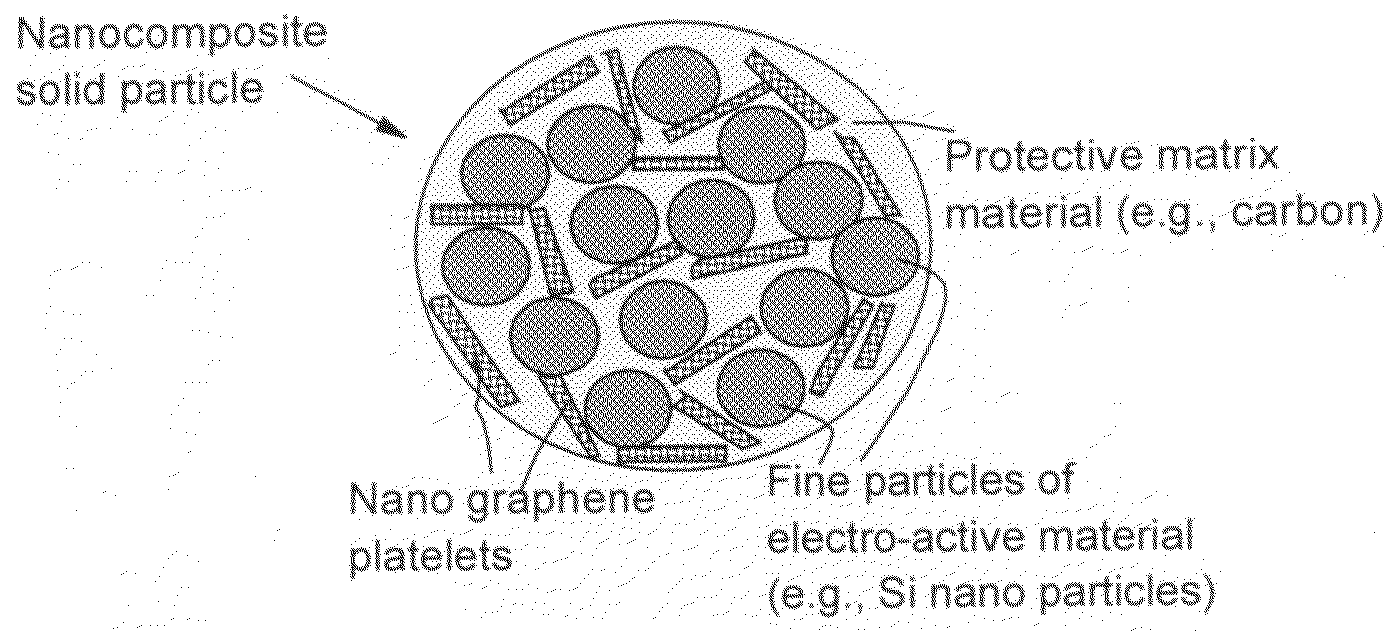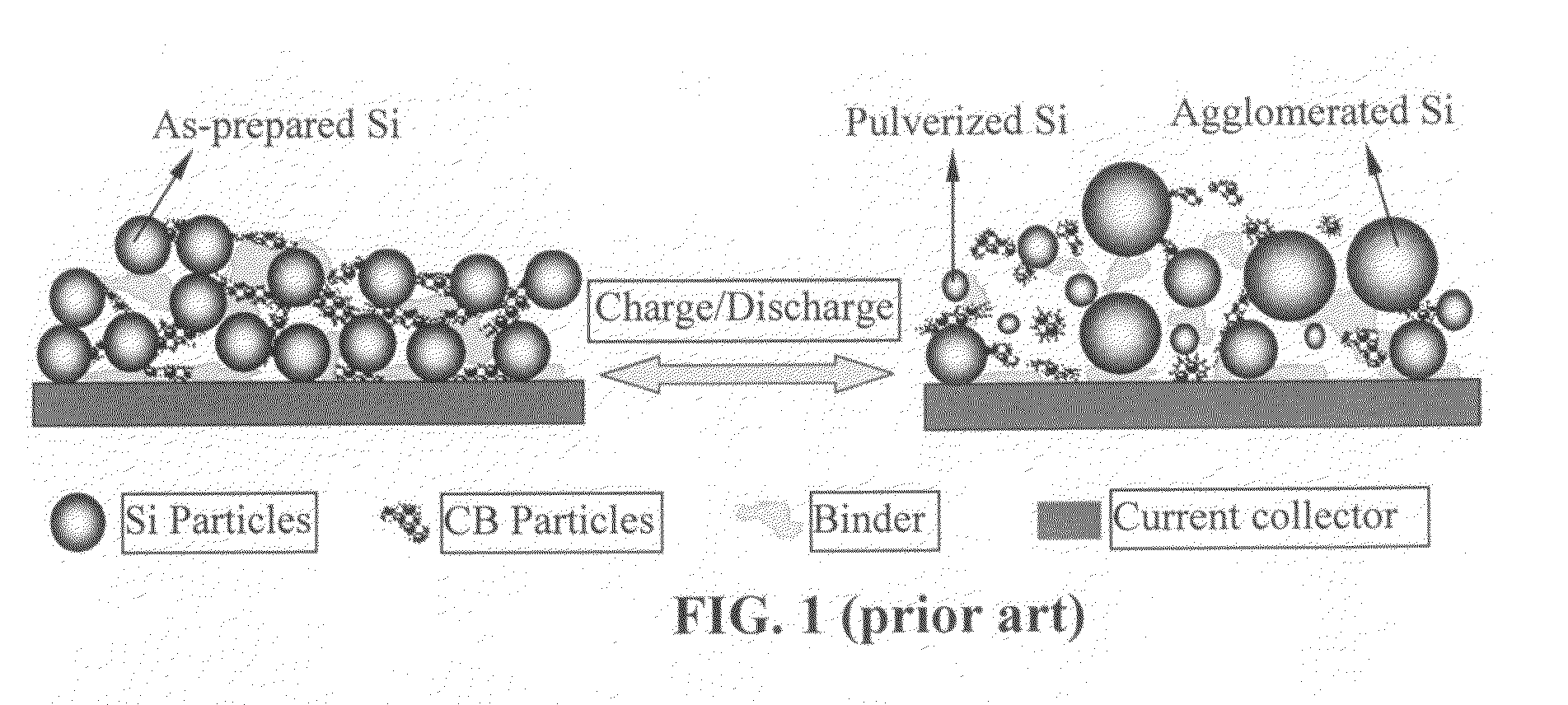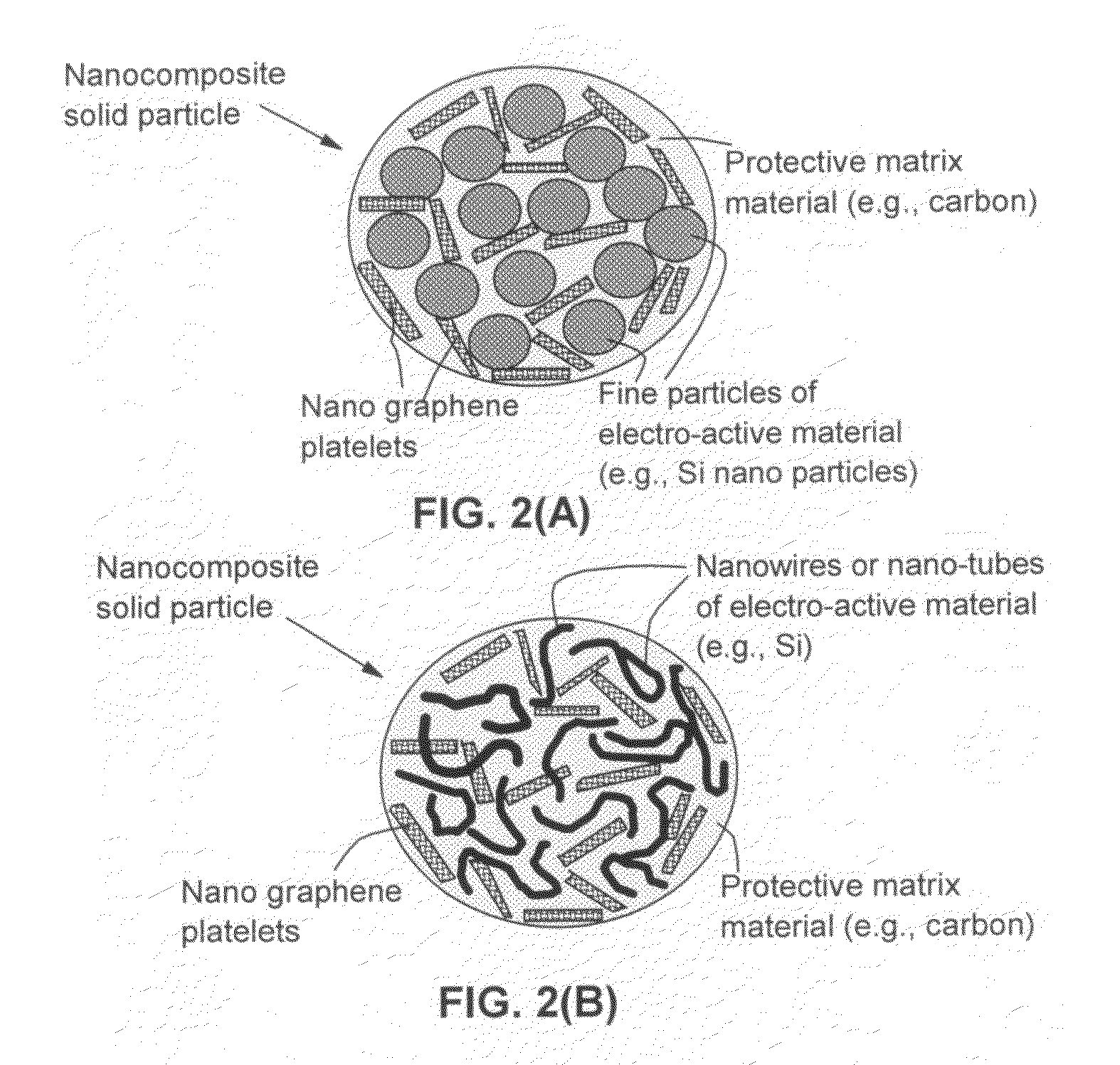Process for producing nano graphene reinforced composite particles for lithium battery electrodes
a technology of lithium battery electrodes and composite particles, which is applied in the direction of cell components, electric vehicles, transportation and packaging, etc., can solve the problems of high cost, inability to produce at a high rate in large quantities, and high cost, so as to enhance the structural integrity of the carbon matrix, reduce the amount of carbon material, and reduce the site of amorphous carbon
- Summary
- Abstract
- Description
- Claims
- Application Information
AI Technical Summary
Benefits of technology
Problems solved by technology
Method used
Image
Examples
example 1
Preparation of NGPs of Various Sizes from Natural Graphite and Production of Corresponding NGP-Reinforced Solid Nanocomposite Particles
[0136]Natural flake graphite, nominally sized at 45 μm, provided by Asbury Carbons (405 Old Main St., Asbury, N.J. 08802, USA) was milled to reduce the size to approximately 14 μm. The chemicals used in the present study, including fuming nitric acid (>90%), sulfuric acid (95-98%), potassium chlorate (98%), and hydrochloric acid (37%), were purchased from Sigma-Aldrich and used as received. Graphite intercalation compounds (GICs), which were actually highly oxidized graphite or graphite oxide (GO) samples, were prepared according to the following procedure:
[0137]In a typical procedure, a reaction flask containing a magnetic stirring bar was charged with sulfuric acid (1.76 L) and nitric acid (0.90 L) and cooled by immersion in an ice bath. The acid mixture was stirred and allowed to cool for 20 min, and graphite (100 g) was added under vigorous stirr...
example 2
Cycling Behaviors of NGP-Containing Nanocomposite, NGP-Free Nanocomposite, and Graphite-Filled Nanocomposite Solid Particle-Based Anodes (all Containing Si Nano Particles)
[0141]In Example 1, a series of samples containing different weight fractions of Si nano particles (2% to 90%) and different weight fractions of NGPs (2% to 90%) in a carbon matrix (5% to 60%) were prepared.
[0142]One of the samples prepared contains approximately 15% NGPs, 60% Si nano particles, and 25% carbon matrix and is herein designated as Sample 1. For comparison purpose, a Comparative Sample 1a was prepared by dispersing Si nano particles (approximately 70%) in a pitch matrix, as in Sample 1 but without the presence of the NGP. A Comparative Sample 1b was prepared by replacing NGPs with fine natural graphite particles (average diameter=3.5 μm) obtained by air-jet milling of natural flake graphite. FIG. 5 shows the half-cell cycling behaviors of Sample 1, Comparative Sample 1a, and Comparative Sample 1b. It i...
example 3
NGP Reinforced Nanocomposite Solid Particles (NGPs Prepared from Other Laminar Graphite Materials)
[0144]NGPs of Samples 3A, 3B, 3C, and 3D were prepared according to the same procedure used for Sample 1, but the starting graphite materials were highly oriented pyrolytic graphite (HOPG), graphite fiber (Amoco P-100), graphitic carbon nano-fiber (from Applied Sciences, Inc., Cedarville, Ohio), and spheroidal graphite (from Hua Dong Graphite Co., Pingdu, China), respectively. Their final interplanar spacings, according to x-ray diffraction data, prior to exfoliation and separation, were 6.6 Å, 7.3 Å, 7.3 Å, and 6.6 Å, respectively. They were exposed to an exfoliation temperature of 950° C. for 45 seconds, followed by a mechanical shearing treatment using a Cowles rotating-blade apparatus for 30 minutes. The resulting suspensions or slurries were then subjected to a drying treatment to obtain NGPs.
[0145]The NGPs, along with various proportions of nano Si particles and SnO particles, wer...
PUM
| Property | Measurement | Unit |
|---|---|---|
| thickness | aaaaa | aaaaa |
| thickness | aaaaa | aaaaa |
| thickness | aaaaa | aaaaa |
Abstract
Description
Claims
Application Information
 Login to View More
Login to View More - R&D
- Intellectual Property
- Life Sciences
- Materials
- Tech Scout
- Unparalleled Data Quality
- Higher Quality Content
- 60% Fewer Hallucinations
Browse by: Latest US Patents, China's latest patents, Technical Efficacy Thesaurus, Application Domain, Technology Topic, Popular Technical Reports.
© 2025 PatSnap. All rights reserved.Legal|Privacy policy|Modern Slavery Act Transparency Statement|Sitemap|About US| Contact US: help@patsnap.com



